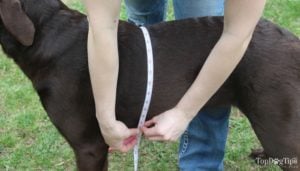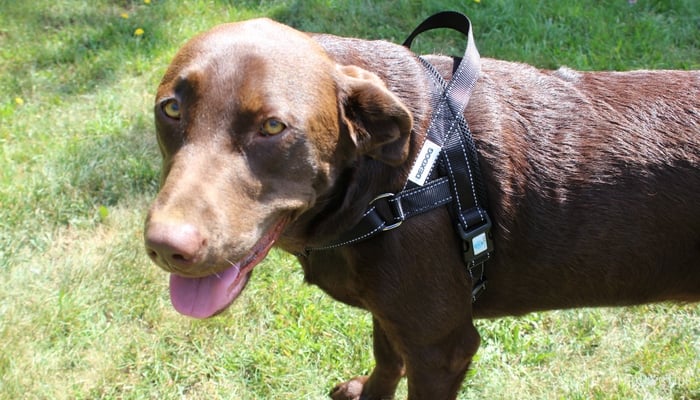Table of Contents
A dog harness is a must-have product for all dog owners because harnesses are much safer than collars. Interestingly, dog harnesses are one of the most commonly returned pet supplies on Amazon because owners often choose the wrong size. Today I'm explaining how to measure a dog for a harness, pick the right type and ensure a proper fit.
Over the years, I've bought and tested (and even reviewed) tons of harnesses with my dogs. While confusing at first, I'm managed to figure out a great technique to measure dog for harness so as to buy the exact size and type for any of my four dogs.
The reason I recommend using pet harnesses over collars is because they disperse the pressure throughout a dog's chest and/or legs instead of their neck/throat. They also offer better control over a dog, which is important when in public around other dogs, strange people or if your pet is a strong puller.
While a dog harness may be a better option than a traditional dog collar, most pet owners have a hard time figuring out which size and what style of a dog harness would be best for their dog, their dog's behavior or the type of activities that they partake in.
So if you're intimidated about buying your first dog harness, or you just bought it and are confused about how to put it on, I'll explain every step of the way: how to measure a dog for a harness, choose the right type, how to fit it and how best to use it on your pooch.
How to Measure a Dog for a Harness

1. Measure Dog for Harness
I know it seems like it would be difficult, but it's actually just two simple steps:
- Measure your dog's neck size
- Measure your dog's chest size
All you'll need is a cloth tape measure like this, and you'll be able to get all the measurements you need to find the perfect dog harness for your canine.
Measure your dog's neck
As I demonstrate in my video above, measure your dog's neck first. Simply wrap the tape measure around your dog's neck where a traditional dog collar would sit (see the above photo). This is your dog's neck size.
Measure your dog's girth
Finding the right size dog harness will also require knowing your dog's girth measurement, which is basically the dog's chest. You need to measure the deepest part of the chest, as this is where the strap of the dog harness will secure around your dog (see the picture below).

Find the deepest part of a dog's chest, which is usually directly below their shoulder blades. Put the start of the tape measure on this spot on their chest, wrap the tape up and around the dog's shoulders, and then back down around their chest. This is your dog's girth – or chest – measurement.
These two measurements is all you need to know how to measure a dog for a harness. At this point, you'll be able to buy a harness that will definitely fit your pooch; however, there are a few more steps to consider.
2. Use Dog Measurements to Buy the Right Harness
After you measure dog for harness, you'll need to pick and buy one. It's best to purchase your dog's harness locally from a pet store, because that gives you the chance to bring your pet with you and try it on before you buy it.
However, dog harnesses online are cheaper in places like Amazon, so if you choose to buy a dog harness online, you can still choose the perfect size but still, be sure that you can return it, just in case. Fortunately, Amazon's great customer service allows for a hassle-free return policy, so no sweat.
Other than return policy, make sure that the product page has Size Chart. Every manufacturer will have slightly different sizing requirements, so without a size chart you're not going to buy the right size of harness for your pet.
Below is a size chart for one of my favorite harnesses, the rabbitgoo (I've bought and did reviews of their tactical harness, LED harness and no pull harness before).
It's pretty self-explanatory. So once you have your dog's chest and neck girth size measurements, all you have to do is pick the size based on this chart. Again, remember that you cannot use one manufacturer's sizing chart for another company's product.
Buying a “standard” dog harness like the rabbitgoo (which is essentially everyday, no-pull harness) is simple. But there are other different types of harnesses and all dogs have slightly different body shapes, so each harness will fit them differently. Sometimes, this may take some trial and error, but let me explain a little about different dog harness styles so you can reduce your chances of having to return the product.

3. Choosing Among Different Types of Dog Harnesses
After you know how to measure a dog for a harness and have the size, style is the next thing to decide on. A dog harness that is comfortable for my Labrador may cause chaffing for your dog of the same breed and similar size.
So in the video above, I demonstrate the two most common types of dog harnesses – an over-the-head harness and a step-in harness. The names pretty much say it all: one slips over a dog's head, and for the other a dog needs to step into the harness.
As you can see, our Saddie prefers the over-the-head harness (the one you see in the video is Dex Dog EZ Harness which I've reviewed here). Honestly, I prefer the over-the-head style harness over any other type. My favorite rabbitgoo harness I mentioned above is also an over-the-head type. These are much easier to put on and take off a dog.
The best thing that you can do if you're new to purchasing dog harnesses is to go to your local pet store and check out the available options, even if you're not buying there. Bring your dog with you, try on multiple styles and see which one you both prefer. This guide has more detailed explanations about different types, and this one about their fitting.
In my video you can see that Saddie isn't a huge fan of either of the step-in harnesses. However, when it's time to put on her over-the-head harness, she is glad to oblige. It just happens to be the best option for both of us, but if you are in doubt – always choose what is best for your dog, and make sure your pet is comfortable and safe.
I hope this helped you to figure out how to measure a dog for a harness and find the right fit, but if you're still confused, please leave your questions in the comments below.
READ NEXT: 6 Best Dog Harnesses for Dogs That Pull
Disclosure: We may earn affiliate commissions at no cost to you from the links on this page. This did not affect our assessment of products. Read more here and find full disclosure here.













